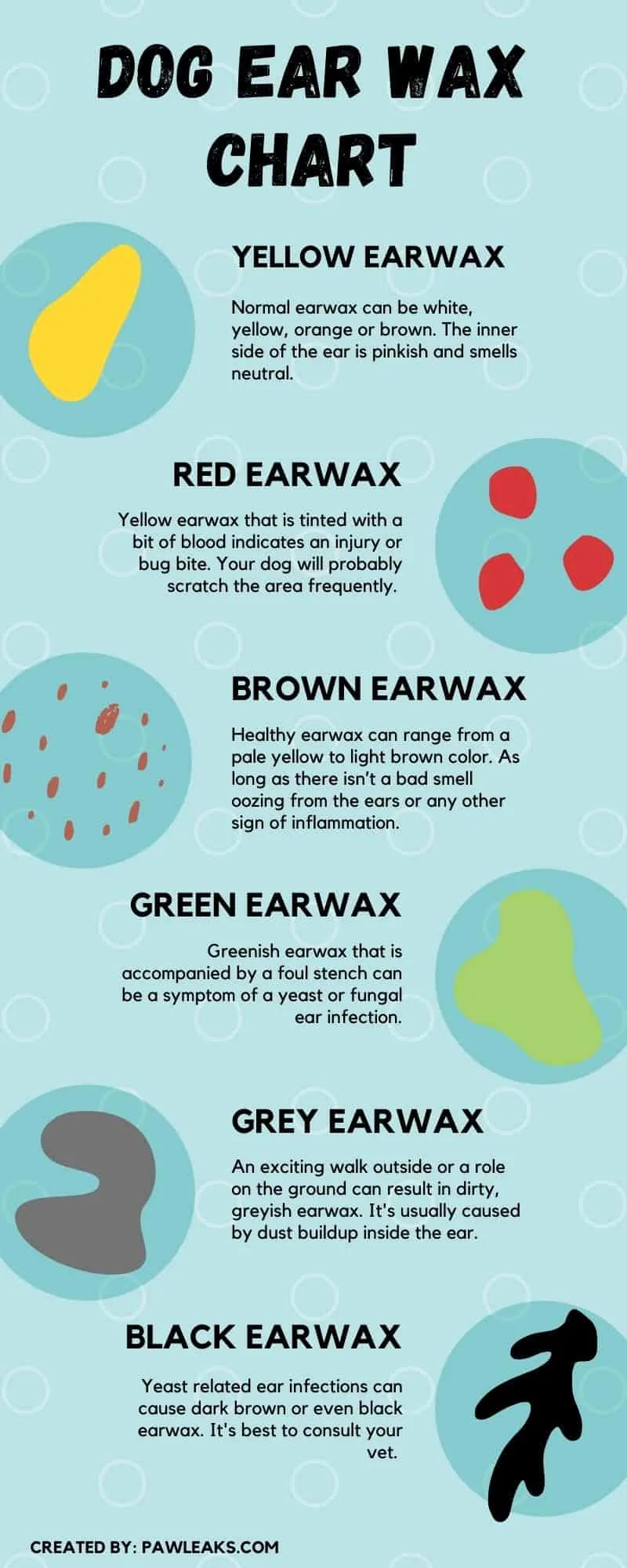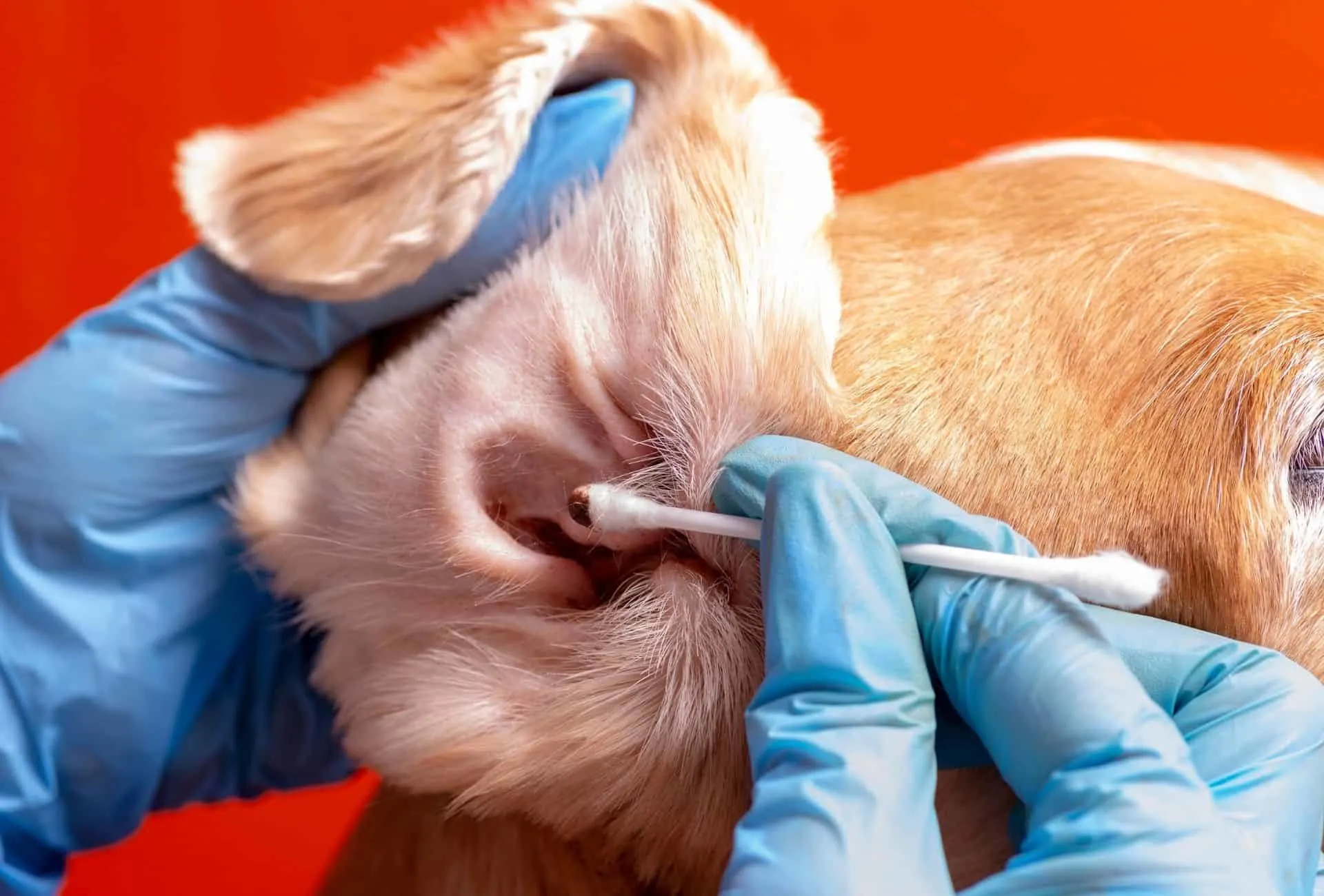Earwax, also called cerumen, is a natural and normal component of your dog’s ear canal.
The cerumen is produced by specialized glands in the ear and has a specific function – collecting dead cells, debris, bacteria, dirt, and pollen.
Once the earwax collects all the unnecessary components it glides and slides out of the ear thus naturally cleaning the ear canal.
So when you notice earwax in your pet’s ears you shouldn’t worry too much, it’s actually necessary to some extent.
However, you should be aware that changes in color, smell, and quantity of ear wax can indicate a health issue.
The ear as an organ consists of three parts – outer, middle, and inner ear.
Owners can observe only part of the outer ear called the pinna (ear flap). The pinna is made out of skin, cartilage, and hair.
Most of the diseases involving the ear are manifested on the pinna so you will be able to detect if something’s wrong.
A healthy inner ear is of pink color and has a small amount of ear wax in yellow or brown color.
A small amount of discharge is also normal as long as there isn’t obvious redness and inflammation.
No bad smell oozing from the ears either if you want to check the healthy box.
Dog Ear Wax Color Chart
Healthy colors for dog ear wax range from yellow to brown while the ear wax colors red, green, gray, and black can indicate health issues such as ear infections or injuries.
When there is too much dirt in the ear, the earwax will have darker variations of brown. The consistency is also important, with semi-soft ear wax indicating healthy wax.
Extreme redness indicates injuries that should be fairly easy to spot while more obscure colors such as green or even black point toward ear infections.
To know exactly what ear wax color is normal, inspect your puppy’s ears at a healthy stage and without any ear conditions.
Keep in mind that some dog breeds have naturally more ear wax than others, such as:
- English Bulldogs
- Poodles
- Basset Hounds
- Cocker Spaniels
The susceptibility stems from various reasons such as skin folds, not shedding hair inside the ear, large ear canals, and genetic predispositions.
Following that logic, many large Mastiff breeds fall under that category as well as dogs with generally long ears where wax is easily trapped and changes the color quickly.
Besides the dog’s breed, other predisposing factors contributing to the development of external otitis are frequent swimming (resulting in excess moisture in the ear), immunosuppression (caused by diseases and medications), too much cleaning of the ears, and viral diseases.
This color chart will help you with determining whether or not your dog’s ear wax is potentially an indicator of an ear infection or infrequent cleaning.

Is Brown Earwax Normal In Dogs?
Brown earwax alone doesn’t indicate an ear condition if there isn’t a bad smell oozing from the ears or any other accompanying symptom of inflammation.
However, if the brown discharge is smelly and has blackish or reddish discoloration it can mean your dog has a problem with his ears.
Overproduction of brown earwax is also not healthy.
Dog Earwax vs. Ear Mites
If your dog suffers from an underlying pathology of the ear canal such as allergy, bacterial infection, or parasite infestation, more ear wax is produced. Similarly, parasites such as ear mites are attracted by a build-up of earwax.
However, ear wax is not a sure sign of ear mites, neither does it mean that your dog has to have lots of ear wax to suffer from ear mites.
To avoid colonies of ear mites feeding off of your dog, clean the ears regularly.
Once the ear mite infestation becomes severe, a gooey-like wax builds up in large quantities. This type of wax usually has fragments of dried blood in it.
Causes & Symptoms of Ear Wax Colors Red, Green, Gray, and Black
The general cause of unwanted earwax in dogs is an infection of the outer ear canal also referred to as otitis externa. This infection and consecutive inflammation can be caused by bacteria, yeast and ear mites.
Infection can also develop secondary to allergies or polyps affecting the ear.
Most common signs of dog outer ear infection include:
- Head shaking (more common than usual)
- Whining
- Scratching of the ears (one or both)
- Too much discharge
- Odor
- Inflamed skin
- Crusts and scabs on the ear flap
In cases when the condition is left untreated and the infection spreads to the middle ear, additional symptoms are loss of balance, hearing loss, and weird eye movements.
Yeast infection caused by Malassezia pachydermatis is the most common type of ear infection in dogs.
This type of yeast infection produces gray or brown ear wax colors or discharge. The ears release kind of a musty and sweet smell and the canal can be narrower.
These microorganisms are part of the normal ear flora but tend to overgrow when the environment in the canal changes.
Matted hair around the ears is common and there can be a crust on the edges of the ear flap.
The second most common type of yeast affecting the ear is Candida albicans, although the incidence is quite rare.
Bacterial infections on the other hand can be exclusive or in combination with yeast infections.
The most common type causing bacteria in dog’s ears includes Staphylococcus pseudintermedius and Pseudomonas spp.
Bacterial infection differs from yeast infection mostly because of the odor from the ear canal. With bacterial otitis, the smell is bad, rotten, and purulent.
The rest of the signs are pretty much similar and the causative agent can be determined with cultural testing of ear swabs.
Evaluating the presence of different microorganisms in the ear canal microscopically by taking a sample is a very useful and commonly used method by veterinarians to determine the source of infection.
This diagnostic procedure is easy and fast to perform and helps narrow down the treatment alternatives.
All of these bacterial and yeast infections in dogs with external otitis are only secondary causes.
They only develop in an abnormal ear and are highly unlikely to happen when the environment in the canal isn’t altered by some other cause.
The only microorganisms that can be a primary cause of otitis externa are Otodected cynotis (ear mites), Trichophyton mentagrophytes, and Microsporum canus.
Even when there isn’t a concurrent condition, these microbes can cause an ear problem.
Generalized conditions like sarcoptic mange, demodectic mange, or severe tick infestations can result in external otitis as well.
So excess way is created when there is an active infection that needs to be dealt with.
The primary reasons that alter the ear canal and provide excellent conditions for bacterial or yeast overgrowth include:
- Endocrine disorders (Cushing, hypothyroidism, sex hormone imbalances)
- Hypersensitivity (atopic allergies, food-borne allergies, FAD)
- Foreign bodies( hair, seeds, plants)
- Tumors (benign, malignant)
- Non-neoplastic polyps
- Autoimmune diseases (lupus erythematosus, pemphigus complex)
- Idiopathic
- Keratinization disorders (excess production of cerumen, seborrhea)
In 50 percent of cases of ear infections, the primary cause is allergy with a foreign body being the second most common cause.
When the primary cause is polyps, tumors, and foreign bodies usually only one of the ears is affected.
Check out my guide on how to treat ear infections at home.
Dog Ear Wax Removal
Cleaning your dog’s ears and removing the wax is not only necessary when there is an ear condition.
Ear cleaning should be a part of the regular grooming procedures.
Although all dogs need to have their ears cleaned, some need it more than others, especially if they are prone to ear infections.
This procedure can be thoroughly done by a vet, but owners can also get pretty good at it with enough practice and a few simple guidelines.

The most important part is choosing the appropriate cleaning solution. You also have to be careful not to over-clean your dog’s ears and cause irritation.
You won’t need any special equipment to remove wax from your dog’s ears.
Besides the cleaning solution, get cotton balls or gauze and treats to reward your furry friend for being such a brave little champ.
Q-tips or cotton tip applicators should be avoided because they can cause trauma to the ear canal and push the wax back inside.
Hold either of the ear flaps vertically thus straightening and exposing the ear canal.
Get the ear cleaning solution in your free hand and squeeze some of it inside the canal.
Stop with the squeezing when the solution starts pouring out. Most ear cleaning solutions have pointy tips – you shouldn’t let the tip touch your dog’s ear.
If this happens, disinfect the bottle with alcohol and a cotton ball.
While still holding the ear flap vertically, massage the base of the ear gently for half a minute.
This procedure breaks up the wax and debris inside the ear and most dogs gladly accept this part of the cleaning.
The squishing sound you will hear means the solution moves in and out of the horizontal part of the ear canal.
At last, use the cotton ball or the gauze to gently wipe out the remaining solution, wax, and debris.
Let your dog shake his head to get all of the solution out and wipe the dirt once more.
Repeat the same process with the other ear and if the pup deserves it, give him a treat as a reward.
Best Dog Ear Cleaner
Avoid anything that contains alcohol or hydrogen peroxide (although this one has its use for other applications) as these ingredients could additionally irritate an already inflamed canal.
There are types of cleaners that have antifungal and/or antibacterial properties and others intended just to break up wax (cerumenolytics).
It is in your dog’s best interest to only use quality ear cleaning solutions for pets.
Discuss with your vet which one to use according to your dog’s ear condition.
Homemade Dog Ear Cleaner
Homemade dog ear cleaners are easy to make. The basic cleaner consists of one part white vinegar (distilled) and two parts water.
Basic homemade ear cleaner for dogs can only be used for regular maintenance of healthy ears.
Informing your vet about intending to use the homemade solution before starting can be helpful in some cases.
How To Clean Dog Ears With Vinegar?
It’s best to use vinegar diluted with water. Personally, I’m using apple cider vinegar and it works well.
The procedure is the same as with the other commercially bought dog ear cleaning solutions.
If you have problems with your dog’s ear wax or wondering whether or not something looks odd, please consult your vet.
Regular cleaning of your dog’s ears should do the trick to prevent excessive earwax in your furry friend.
